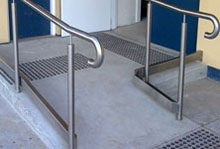
Access Ramps Resources
- Home
- Types of Access Ramps
- Access Ramps for Disabled
- Access Ramps for Sale
- Access Ramps for Wheelchairs
- Ada Access Ramps
- Building Access Ramps
- Disability Access Ramps
- Disabled Access Ramps
- Disabled Access Ramps Regulations
- Easy Access Ramps
- EZ Access Ramps
- FAQs Access Ramps
- Handicap Access Ramps
- Handicapped Access Ramps
- Lightweight Access Ramps
- Modular Access Ramps
- Portable Access Ramps
- Portable Disability Access Ramps
- Vehicle Access Ramps
- Wheelchair Access Ramps
Disability Access Ramps
In the United States, disability access ramps are a day-to-day Godsend, not only for wheelchair users, but many others who cannot easily go up or down stairs, such as parents with baby strollers. The ADA have issued a number of practical guidelines and rules relating to the construction of disability access ramps for public places, be they permanent, semi permanent or mobile disability access ramps. It’s important to note that rules also apply to disability access ramps around your home. If you are not sure about the restrictions regarding installing disability access ramps in private premises, take time to visit your local building planning officer, he or she will be more than happy to advise you.
Key disability access ramps requirements
Any disability access ramps will be able to have a maximum incline of 1:12. This means that the elevation can be 1 foot for every 12 of ramp. The disability access ramps need to have landings at both the top and the bottom that need to be as wide as the ramp itself. The maximum distance of a single run for disability access ramps is 30 feet without a landing. Sometimes, it is not possible to construct a ramp that is straight from departure point to destination, in this case it will be necessary to create cross run ramps. The regulations for these cross run ramps are very clear; firstly a level landing needs to be located at the point of the curve. In this way the wheelchair user can maneuver without the fear of rolling backwards or forwards unexpectedly. Secondly, the dimensions of the turning area need to be a minimum of 60 inches by 60 inches to ensure plenty of room for maneuver.
Handrails and construction are important for safety
Handrails on disability access ramps are essential safety accessories and a single handrail is required on all permanent disability access ramps. It is also possible to buy short mobile disability access ramps that come with foldable handrails too. If disability access ramps are longer than 6 feet, handrails will need to be provided on both sides of the access ramp. It is recommended that the width of the disability access ramps with handrails should be no narrower than 48 inches to allow sufficient room to install the handrails and maintain a usable disability access ramp with space of 36 inches inside the handrails. The ideal handrails should be set at a height of 36 inches from the floor of the disability access ramps and an intermediary hand rail set at about 28 inches is useful for children who are wheelchair users. All access ramps should have a non skid surface and allow water to drain off quickly and efficiently to avoid the danger of icing in winter conditions.
Installing disability access ramps at home
Internally, there are no restrictions in the design of your access ramps, apart from using good sense and strong materials such as hardwood, aluminum or steel. Externally, there can be certain restrictions that your local planning office can advise you about. Residential disability access ramps are not governed by the same strict rules applying to the ones in public areas, but to use the same design criteria wherever possible makes good sense.
